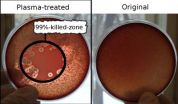That is one conclusion drawn by researchers at the Salk Institute for Biological Studies, who recently showed that mice lacking a gene regulating energy balance are protected from weight gain, even on a high fat diet. These findings have implications for the worldwide obesity epidemic and its consequences, such as type two diabetes.
In the December 16, 2010 issue of Nature, a team led by Marc Montminy, M.D., Ph.D, professor in the Clayton Foundation Laboratories for Peptide Biology, reports that a gene known as CRTC3 decreases energy expenditure by fat cells. "Ideas about obesity are based on concepts of feast or famine," said Montminy. "As humans, we developed ways of coping with famine by expressing genes like CRTC3 to slow the rate of fat burning. Individuals with these active "thrifty genes" had an advantage-they could survive long periods without food."
The idea that mammals harbor genes that slow fat burning was proposed in the 60's, before any genome was sequenced. Some theorized that such thrifty genes provided a survival advantage to our hunter-gatherer ancestors, who often went a long time between meals and needed to hold on to their fat depots. In 2010, however, those genes have become a liability.
To analyze its role in fat metabolism, the researchers engineered mice lacking the CRTC3 gene and put them on diets of varying fat composition. Normal and CRTC3 gene "knockout" mice appeared similar when fed a moderate fat diet. But when fed the mouse version of the Philly cheese steak diet, only the normal mice became obese. "The CRTC3 knockout mice were leaner and protected from obesity," reports Montminy. "They also had about twice as many brown fat cells than did normal mice."
To appreciate this finding, keep in mind that not all fat cells are "bad". When you deplore your waistline, what you are deploring is white fat tissue (also called WAT, for "white adipose tissue"), which serves as a fat storage depot around the midsection and hips. However, a second type of fat-known as brown fat (BAT)-is downright desirable.
"Brown fat is very different from white fat," says Youngsup Song, Ph.D., a postdoctoral fellow in the Montminy lab and the study's first author. "Brown fat tissue burns fat that has accumulated in white fat tissue to generate heat as a way to maintain body temperature."
In fact, some evidence suggests that humans with a genetic propensity to leanness have more brown fat cells than do "ample" individuals. As desirable as that trait may seem in a "super-size me" world, those folks likely had a pretty tough time in the Paleolithic era.
Although the researchers found that CRTC3 loss also perturbs how all fat cells respond to brain signals controlling energy expenditure, they remain particularly intrigued by the brown fat connection. "CRTC3 could be a switch controlling the number of brown fat cells, " says Montminy. "That is key, because if you could make more brown adipocytes, you could potentially control obesity."
To explore how relevant these studies are to humans, Montminy asked clinicians at Cedars-Sinai Medical Center in Los Angeles to search databases of patient genetic information for a particularly interesting human CRTC3 gene mutation, which appeared to represent a more potent form of the normal gene.
Since mice lacking CRTC3 resist obesity, the researchers reasoned that people carrying a revved-up version of the gene might show the opposite tendency. Indeed genetic testing of two groups of Mexican American patients revealed that individuals harboring the active CRTC3 mutation showed increased incidence of obesity.
"This is an example in which findings from rodent research led to a novel discovery in humans," says Mark Goodarzi, M.D., Ph.D., an endocrinologist at Cedars-Sinai and collaborator in the study. "Not all Mexican American individuals with the variant will develop obesity, but those carrying it are at higher risk." Interestingly, non-Hispanic Caucasians carrying the variant do not show increased obesity, a difference likely related to environmental or lifestyle factors.
Overall this study illustrates an important principle: that what is genetically advantageous in one cultural or historic context may not be in another. In fact, Montminy does not view obesity as an aberration or a "disease". "Storing fat in adipose tissue is a normal response. A lot people are obese but do not develop type 2 diabetes," he says, suggesting that genes like CRTC3 could serve as diagnostic tools as well as drug targets. "A goal is to go to your doc and learn whether you have the risk factors to progress to diabetes."
INFORMATION: Also contributing to the study were Judith Altarejos, Ph.D., Hiroshi Inoue, MD, Ph.D., Rebecca Berdeaux, Ph.D., Jeong-Ho Kim, Ph.D., Jason Goode, Motoyuki Igata, MD., Jose Paz, Ph.D., Meghan Hogan, Pankaj Singh, Ph.D., Naomi Goebel, Lili Vera, and Nina Miller-all of the Salk Institute-and Xiuqing Guo, Michelle Jones, Yii-Der Chen, Kent Taylor, and Jerome Rotter, MD, of Cedars-Sinai Medical Center in Los Angeles, and Willa Hsueh, MD, of Methodist Hospital Research Institute in Houston.
The research was funded by grants from the National Institutes of Health, the Kieckhefer Foundation, the Clayton Foundation for Medical Research, the Helmsley Foundation, the Cedars-Sinai Winnick Clinical Scholars Award, and the Cedars-Sinai Board of Governors Chair in Medical Genetics.
About the Salk Institute for Biological Studies:
The Salk Institute for Biological Studies is one of the world's preeminent basic research institutions, where internationally renowned faculty probe fundamental life science questions in a unique, collaborative, and creative environment. Focused both on discovery and on mentoring future generations of researchers, Salk scientists make groundbreaking contributions to our understanding of cancer, aging, Alzheimer's, diabetes and infectious diseases by studying neuroscience, genetics, cell and plant biology, and related disciplines.
Faculty achievements have been recognized with numerous honors, including Nobel Prizes and memberships in the National Academy of Sciences. Founded in 1960 by polio vaccine pioneer Jonas Salk, M.D., the Institute is an independent nonprofit organization and architectural landmark.
The Salk Institute proudly celebrates five decades of scientific excellence in basic research.


